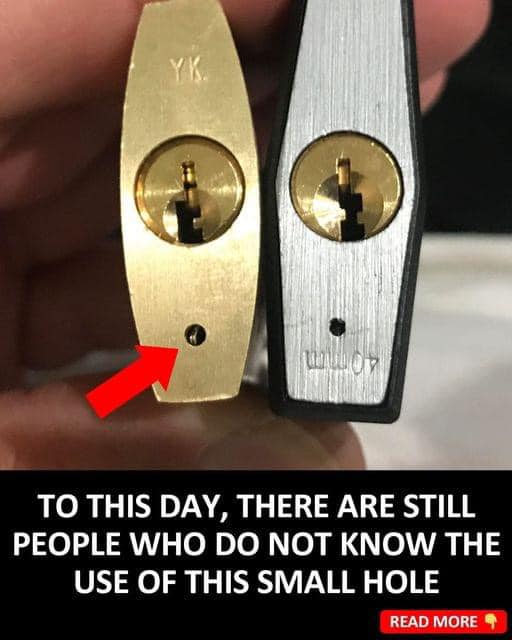Padlocks are simple yet effective tools used to secure various belongings, from bikes and toolboxes to gates and outdoor sheds. They are designed to resist cutting and withstand tough weather conditions. However, many people may not know about a small, mysterious hole found at the bottom of most padlocks. This little feature, while often overlooked, serves a crucial function that helps enhance the padlock’s longevity and performance.

The Purpose of the Padlock Hole
Padlocks are primarily made of metal, which means they are prone to rust, especially when exposed to rain or high humidity. That’s where the small hole at the bottom of the padlock comes in handy. This hole acts as a drainage outlet, allowing any water that enters the lock to escape. By letting water drain out, the hole prevents moisture from accumulating inside the padlock, which would otherwise lead to rusting and potential damage to the internal components.
This simple drainage system is a clever design feature that keeps the lock functioning properly over time, even in harsh weather conditions. It also helps ensure that the padlock remains secure and reliable, protecting your belongings for a longer period.
The Evolution of Weatherproof Padlocks
While the drainage hole was a significant innovation in padlock design, modern advancements have led to the creation of weatherproof padlocks. These newer models are specially designed to withstand extreme conditions, often using protective coatings that shield the internal mechanisms from water, dust, and other elements. Weatherproof padlocks don’t always rely on a drainage hole, as their materials provide a higher level of protection.
However, the traditional padlock with a small hole remains a popular choice due to its simplicity and effectiveness. It continues to serve as an essential feature for many types of locks, offering a basic yet reliable solution to prevent rust.
Lubricating Through the Padlock Hole
In addition to serving as a drainage point, the small hole at the bottom of a padlock also plays a role in maintenance. Over time, dirt and debris can build up inside the lock, making it difficult to open, even with the correct key or code. The hole allows users to apply lubricant directly into the lock’s internal mechanism, loosening any stuck components and making it easier to operate.
Applying synthetic oil or another type of lubricant through this hole can help ensure that the lock opens smoothly and remains in good condition. This dual purpose makes the tiny hole a critical part of padlock functionality, helping maintain the lock’s reliability while extending its lifespan.
Other Everyday Items with Hidden Features
Padlocks are just one example of common items designed with hidden yet functional features. Many everyday tools and objects have clever design elements that serve multiple purposes, often without users realizing it. Here are a few more:
Screwdrivers as Wrenches
Most people think of screwdrivers solely as tools for driving screws, but they can also function as makeshift wrenches. Many screwdrivers are designed to fit into the open end of a wrench, providing additional leverage when working in tight spaces. This feature adds versatility to a basic tool, making it more useful for a wider range of tasks.
Color Swatches on Clothing
You may have noticed that some clothing items come with small fabric swatches, but not everyone knows why. These swatches are not just for color matching when repairing tears—they can also be used to test the effects of laundry detergents or cleaning agents on the fabric. By testing cleaning products on the swatch first, you can prevent potential damage to the actual garment.
Brass Padlocks and Doorknobs
Brass is a common material for padlocks, doorknobs, and handrails, not just because it’s durable, but also because it has antibacterial properties. Brass surfaces can help reduce the spread of germs, making it an ideal choice for items frequently touched by many people.
Gas Tank Indicators in Cars
It’s easy to forget which side of the car the gas tank is on, especially if you’re driving an unfamiliar vehicle. Car manufacturers have added a small triangular indicator near the gas gauge on the dashboard to solve this problem. The triangle points to the side of the vehicle where the gas cap is located, providing a quick and convenient reminder.
The “57” on Heinz Bottles
The iconic “57” on Heinz ketchup bottles is more than just branding. On glass bottles, it indicates the best spot to tap when trying to get the ketchup to flow more easily. It’s a simple design choice that improves the user experience, making it easier to pour the sauce without vigorous shaking.
Conclusion: The Genius of Everyday Design
From the drainage hole in a padlock to the gas tank indicator on your car, many common items have been designed with hidden features that make them more useful than they first appear. These subtle design elements demonstrate how thoughtful engineering can enhance functionality and make life a bit easier. So, the next time you see a small feature on a familiar item, remember—it might just have a more significant purpose than you initially thought.





